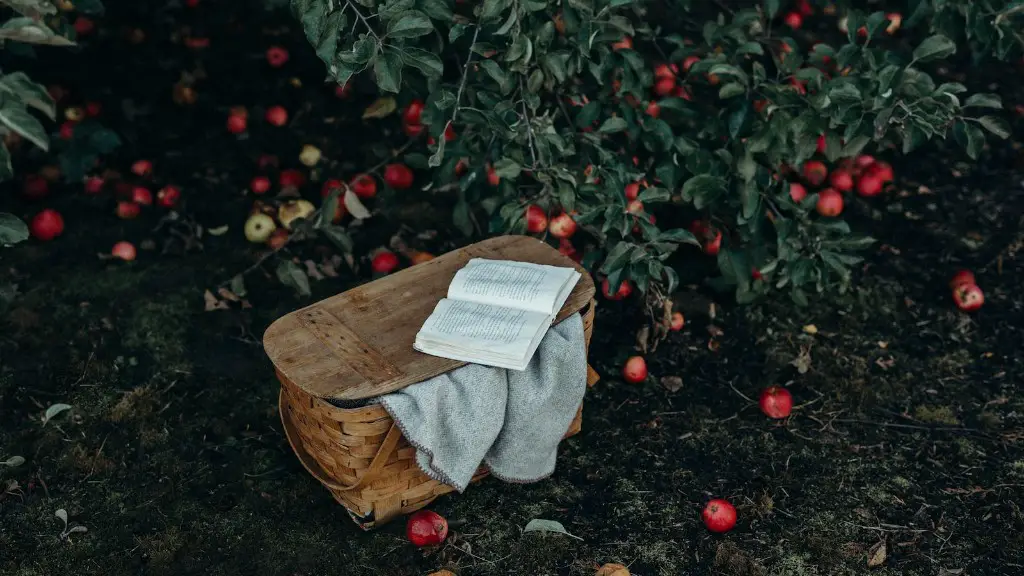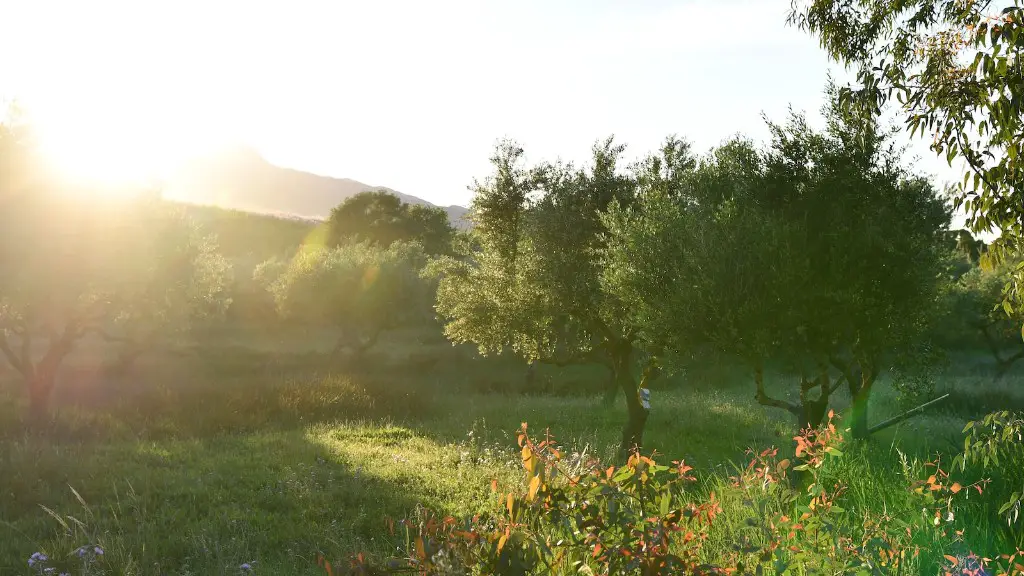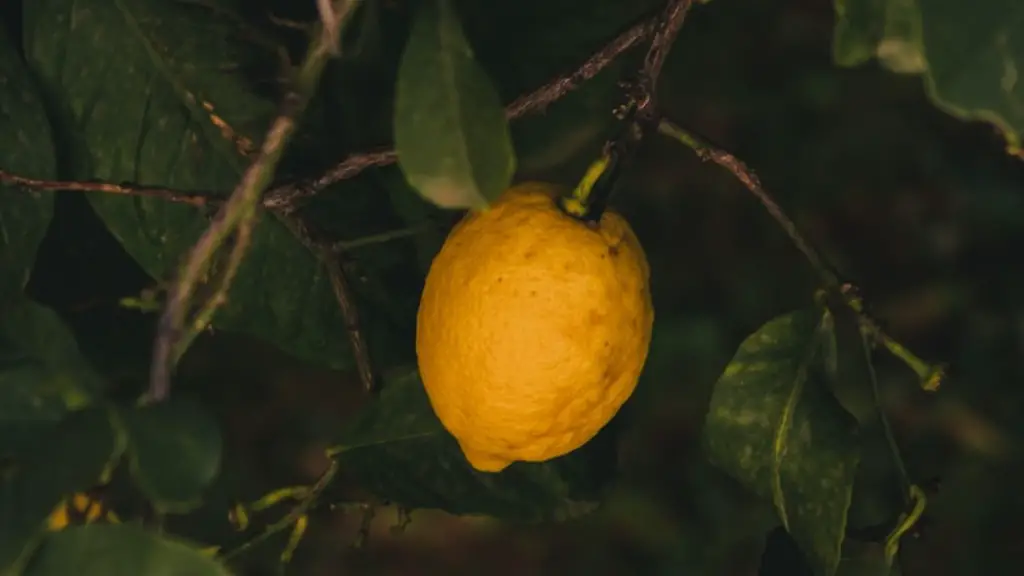Apples are a common sight in fruit trees and are often the victim of splitting. The split apple phenomenon is often seen across certain varieties of apple trees, and some people may be wondering what causes apples to split, and how to prevent it in the future. This article answers these questions by examining the contributing factors, the process of splitting, and different methods to reduce the effects.
Split apples are caused by multiple factors, the primary contributor being heavy rains. During heavy rain, apples absorb large amounts of water, causing the cells which make up the fruit to rapidly expand. The expansion in apple cells is further accelerated when the tree is also experiencing a period of growth. If the water-weighted fruit is exposed to extreme sunlight and heat, the cells can split along the sides and cause a visible break in the apple.
The secondary factors which can contribute to split apples are the mineral and nutrient content within the soil and water supply. Low levels of calcium and iron can result in fruit splits, as these minerals are necessary for apples to reach their full size. Furthermore, a limited water supply can lead to the apples using more energy to expand, so that an individual apple can reach it’s full size in an area with a small water supply.
Once the structure of the tree is ruptured, the affected apple can either burst or fall off the branch. If the apple is intact, it can still be harvested and consumed, however, if the apple is excessively split, it will be difficult to consume and may even contain insect infestations.
Split apples can affect the flavour and quality of the tree, so it is important to take proactive steps to reduce the threat of splitting. It is important to provide adequate water and nutrients to the tree, from a mixture of soil conditioners and fertilizer. Furthermore, it is necessary to keep the tree pruned and properly maintained to reduce the risk of moisture damage to the apples.
Finally, an important preventative measure to reduce split apples is to reduce the amount of sunlight exposure. This can be done by employing specialized tree control systems to reduce the amount of light the tree is exposed to, whilst also providing ample amounts of shade from the sun.
To conclude, there are numerous factors which can cause apples to split on the tree, and it is important to take steps to reduce the effects. Heavy rains, low nutrient and calcium levels, inadequate water supply, and excess sunlight can all contribute to the splitting process, so it is critical to employ preventative measures such as pruning, fertilizing, and shading techniques to minimize the risk of split apples.
Preventative Measures to Reduce Split Apples
Understanding how apples can split on the tree is an important part of making sure that fruit trees are healthy and productive. Whilst there are several environmental factors that can contribute to the process, understanding preventative measures is the key to making sure that no apples are lost due to splitting.
The most important step to preventing split apples is to ensure that the tree is adequately watered and nourished. A balanced soil mix of soil conditioners, mulch, and fertilizer are all important to make sure that the tree has the minerals and nutrients that it needs. Furthermore, it is important to keep the tree pruned, as this will help to reduce the risk of moisture damage to the apples.
In addition to providing adequate water supply and nourishment for the tree, limiting the amount of sunlight that the tree is exposed to can greatly reduce the chances of split apples. This can be done by positioning the tree in an area which gets less direct sunlight and installing specialized tree control systems which can reduce the effects of sunlight.
Finally, it is important to regularly check the trees for splitting apples, as potential problems could go undetected until it is too late. Regularly inspecting and monitoring the trees can help to reduce the risk of split apples, and provides an opportunity to quickly detect problems before they become severe.
Effects of Split Apples on Tree Quality
Split apples can have a significant effect on the quality of a tree, and can often lead to other problems if measures are not taken to reduce it. The most obvious effect is that the final yield of the tree will be reduced, as a large number of apples will be unusable due to their splitting. In some cases, a heavy influx of split apples can reduce the crop yield by more than half.
Split apples can also cause significant damage to the structure and integrity of the branches of the tree. The trees can become weak due to weakened branches, and may even collapse due to the weight of the split apples. Furthermore, split apples are a prime breeding ground for parasitic insects, which can damage the health of the tree and cause further splitting.
In addition to damage to the tree itself, split apples are also a health hazard to other fruit trees in the surrounding area. Insects which feed on split apples can spread diseases to adjacent trees, and in some cases, these diseases can spread even further.
Another common problem associated with split apples is that it can reduce the quality of the final product. Apples that are heavily split will not look appealing to consumers and are often unsuitable for sale in supermarkets, making them difficult to sell.
Finally, split apples can cause a decrease in the value of a tree. Poorly maintained trees, or those with a large number of split apples, can be seen as a waste of resources and can cause the value of the tree to significantly decrease.
How to Reduce Split Apples on Fruit Trees
Reducing split apples on fruit trees is often a difficult task, as understanding the contributing factors can be difficult. However, there are several strategies which can be employed in order to control the extent of splitting on the tree.
The most important steps are to ensure that the tree is sufficiently watered and nourished, particularly when the tree is in the middle of a growth cycle. In addition to this, it is also important to regularly prune the tree in order to reduce the risk of moisture damage to the apples, as well as positioning the tree in an area which receives less direct sunlight.
Furthermore, using specialized tree control systems can be very effective in reducing the amount of light the tree is exposed to. This is particularly effective when employed in conjunction with shading techniques, a popular solution being canvas or mesh covers which can reduce the effects of sun exposure.
Finally, monitoring and inspecting the tree on a regular basis is often the best way to detect potential problems. This can help to identify and reduce the areas of highest risk in order to minimize the threat of split apples.
Treating Split Apples on a Tree
In some cases, split apples may already be present on the tree, and it can be difficult to know how to best treat them. Whilst there is no definitive solution to the problem, there are several steps that can be taken to minimize the damage.
The first step is to remove any insects or pests that may have been attracted by the split apples. This can be done by using insecticides or natural methods such as planting pest repelling plants in the vicinity of the tree. Furthermore, it is also important to disinfect the area to further reduce the risk of infection.
In addition to this, it is also important to prune the branches which have been affected by the split apples. Pruning helps to reverse the damage caused by the split apples, as well as improving the overall structure and health of the tree.
Finally, it is important to keep the tree in a sheltered area that is free from excess heat and sunlight. This can be done by installing shade cloths over the tree, or moving it to an area with less sunlight exposure.
The Impact of Split Apples on Fruit Quality
Split apples can significantly reduce the overall quality of the fruit produced by a tree, and can often lead to unappealing, sour-tasting, or even diseased fruit. Whilst there are several factors which can contribute to the splitting of apples, understanding the impact of split apples on fruit quality can help to take steps to reduce it.
One of the most significant impacts is the reduction in flavour and sweetness of the apples, as the split apples will often contain sour or acidic juices. This can ruin the flavour of the apples, making them inedible for human consumption.
Another issue is the risk of disease, as split apples are prone to infestations from parasitic insects which can spread diseases throughout the fruit. This can cause the apples to rot and produce toxins that can affect the fruit’s quality. Furthermore, it can also reduce the overall shelf life of the apples, making them difficult to store and transport.
Finally, split apples are often an eye-sore when presented to customers, and can significantly reduce the value of the final products. As a result, it can be difficult to sell split apples, as they are frequently disregarded by consumers as being inferior to other varieties of apples.





